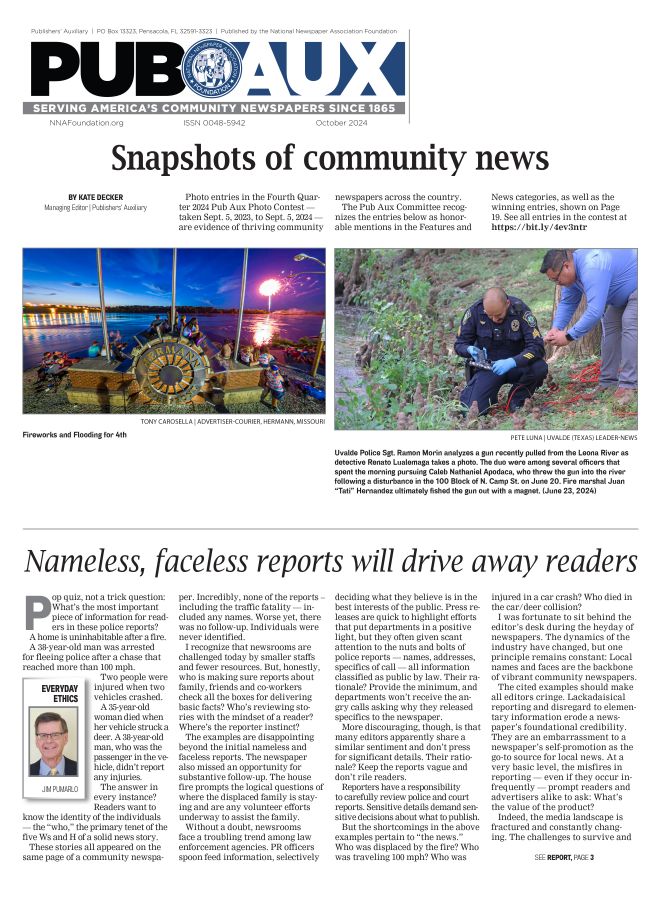USPS may be required to do rural mail studies
Aug 1, 2015
By Tonda F. Rush
CEO and General Counsel | NNA
WASHINGTON—The U.S. Postal Service could soon be required to produce regular studies of on-time delivery of rural and small-town mail. The National Newspaper Association asked for these studies in March comments to the Postal Regulatory Commission.
Now a key congressional committee is mandating the studies.
Because USPS closed nearly 150 mail processing plants, mostly in smaller urban and rural areas, reports of problems with rural delivery in all mail classes have abounded, and many have reached members of Congress. Typical was the comment submitted by NNA Vice President Chip Hutcheson: “We have experienced severe degradation of service since January 2015. Our newspaper is prepared for maximum delivery outside our county, yet we find subscribers 30 miles away not receiving a paper for seven days after it has been mailed. Also, First Class Mail has deteriorated greatly. There will be a large pile of mail one day, virtually nothing the next, and that cycle seems to repeat itself. Our local utility has experienced problems with customers not getting their bills on time.”
The Postal Service has been required since 2008 to measure on-time mail delivery for every class of mail each fiscal quarter and report results to the PRC. Its data are drawn from a variety of sources, including reports by in-home monitors provided by its contractor IBM. But NNA worked with the monitors in 2008 to develop a study for in-county mail and found it difficult to find monitors in communities served by most small NNA newspapers. USPS now wants to cast aside the in-home monitor system and rely solely on data from its own scanning technology. NNA told the PRC it supports the USPS proposal, hoping the new system will be more useful for community newspapers than the old one. But NNA said more robust data from rural areas must be developed and reported.
In July, the Senate Appropriations Committee agreed with NNA. At the request of Sen. Roy Blunt, R-MO, the committee adopted a requirement for USPS to create exactly the sort of study NNA asked for. It would require measurement of service from rural areas to rural areas, rural to urban areas and urban to rural areas.
The measure still might not become law. Numerous controversies reside in other parts of the bill, including funding cuts and new restrictions on the Internal Revenue Service for its reported discrimination against certain non-profit associations. But even if the law is not enacted, USPS and PRC may decide to go ahead.
“We are gratified to learn that USPS and the PRC have already been meeting to decide how to fulfill NNA’s request. They have to work out a lot of details, such as the definition of ‘rural’ and how often, where and when the studies will be done. I am glad to hear it. They are the experts, and they know how to get this done,” said NNA Postal Committee Chair Max Heath. “What is important to us is that they begin somewhere. We need a baseline to see whether service is improving or declining. We are facing more plant closings in 2016. Some metrics to let us know how hard these changes are hitting our smaller communities are urgently needed.”
NNA’s work is designed to benefit small towns, not solely newspapers, according to NNA Government Relations Chair Deb McCaslin, executive editor of the Custer County (NE) Chief.
“Ironically, newspapers may not be the first to see results from this study because USPS will be using its barcode technology. We are a good ways away from getting newspaper delivery measured that way. But this study is important to our towns, and NNA is providing an enormous service for our readers and businesses by instigating this project. Healthy communities lead to informed citizens, and that helps all of us. But if the mail is broken, the community is not healthy. We want to see the Postal Service moving ahead quickly on rural mail measurement,” she said.







